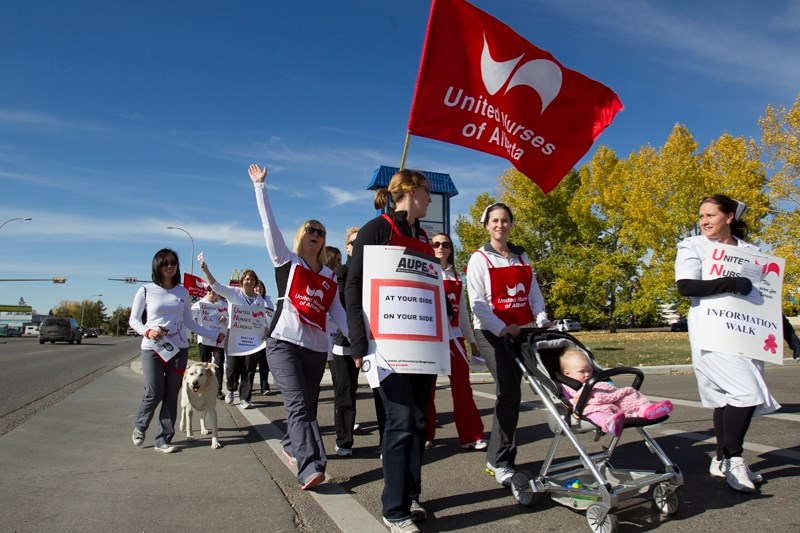Receiving a cacophony of supporting honks from passing motorists, roughly 60 nurses marched along Highway 27 on Oct. 4 to share their concerns with the public about staffing levels for nurses and patient care at the Olds Hospital and Care Centre.
The group of registered (RN) and licensed practical (LPN) nurses from throughout the region, many of whom dressed in symbolic white smocks and caps, carried flags and signs with slogans such as “Nurses are the heart of health care,” “Stop the cuts to frontline staff,” and “Expert care saves lives” as they walked from the Westview Co-op to the hospital along the highway and 57 Avenue.
“The walk today is to raise public awareness that Alberta Health Services and the Alberta government have started initiatives to cut RN and LPN jobs at the bedside so skilled, educated, professional, regulated nurses would be replaced by unregulated, less-skilled nurses like health-care aides,” said Heather Venneman, a registered nurse at the hospital and president of the local chapter of the United Nurses of Alberta union that represents nurses at the hospital.
Due to cuts to staffing levels and working hours at the hospital, she added, in some cases one RN and LPN are responsible for caring for between as many as 13 to 50 patients depending on what part of the hospital they work in or what time of day their shift covers.
A healthy ratio, Venneman said, is more like one nurse to four or five patients.
With such low numbers of RNs and LPNs in place at the facility, nurses are now concerned about patient safety as well as nurse burnout and stress.
“It's a very emotional job,” Venneman said. “You don't go home and leave your work at work.”
When asked if the current nurse-to-patient ratios are negatively affecting the care patients are receiving at the hospital, she said nurses are “working so hard to see that it doesn't happen.”
“They're doing the best they can. They're tired of saying ‘We're sorry, but we don't have enough staff.'”
Debora Coombes, chair of the Alberta Union of Provincial Employees' local chapter representing LPNs at the hospital, also said staff shortages and a failure by AHS and the province to replace staff at the hospital is leading to nurse burnout.
“We're all tired,” she said, adding roughly 35 LPNs work in acute care at the hospital, compared to roughly 70 RNs.
“It's about the patients and quality care and we are a team. Even though we are two unions, we are a team.”
Ultimately, Venneman said, the nurses taking part in the information walk hoped the people who saw them marching towards the hospital would hear their concerns and start calling MLAs and provincial health leaders for change.
“I want them to hear that this is no way to run a health-care system by removing RNs, LPNs, those educated, skilled nurses from the bedside. We are the health-care system.”
Although Venneman said she had not asked doctors at the hospital for their opinion on nurses' concerns, one doctor did honk in support of the rally as he drove past the group near the hospital.
Once they arrived at the facility, the nurses were not allowed to step onto hospital property and a security guard was visible patrolling the grounds.
Instead, the nurses focused their message on people coming and going from the hospital.
Deb Gordon, a chief health professions officer for Alberta Health Services, could not speak about specific conditions at the Olds hospital but said AHS has not turned its back on nurses.
“From AHS's broad perspective we absolutely do need nurses and we are hiring nurses and we have increased and are continuing to increase our nursing workforce,” she said, adding that since 2010, Alberta's overall nursing workforce has grown by 13 per cent.
And in the first quarter of this fiscal year, Gordon said, the largest increase in the province's clinical workforce was in nursing.
“We absolutely still are looking for nurses,” she said. “If we don't continue to hire nurses, we simply will not have enough health-care workers in the long run to make up for retirements, turnover and growth in the system and so we absolutely intend to continue to hire all capable, qualified nurses that we can.”
As for concerns about replacing trained and regulated nurses with care aides, Gordon said that if a patient or a family needs the skills of an RN or LPN, they will receive a nurse's care.
If the skills of a health-care aide can meet such needs, an aide will assist a patient or family and nurses and aides will work together as a team, she added.
Gordon also said she has heard that some new nurses have had trouble connecting with AHS to find work and if that's the case, AHS offers a “matching service” for graduates from nursing schools.
Nursing graduates can reach AHS by emailing [email protected].



